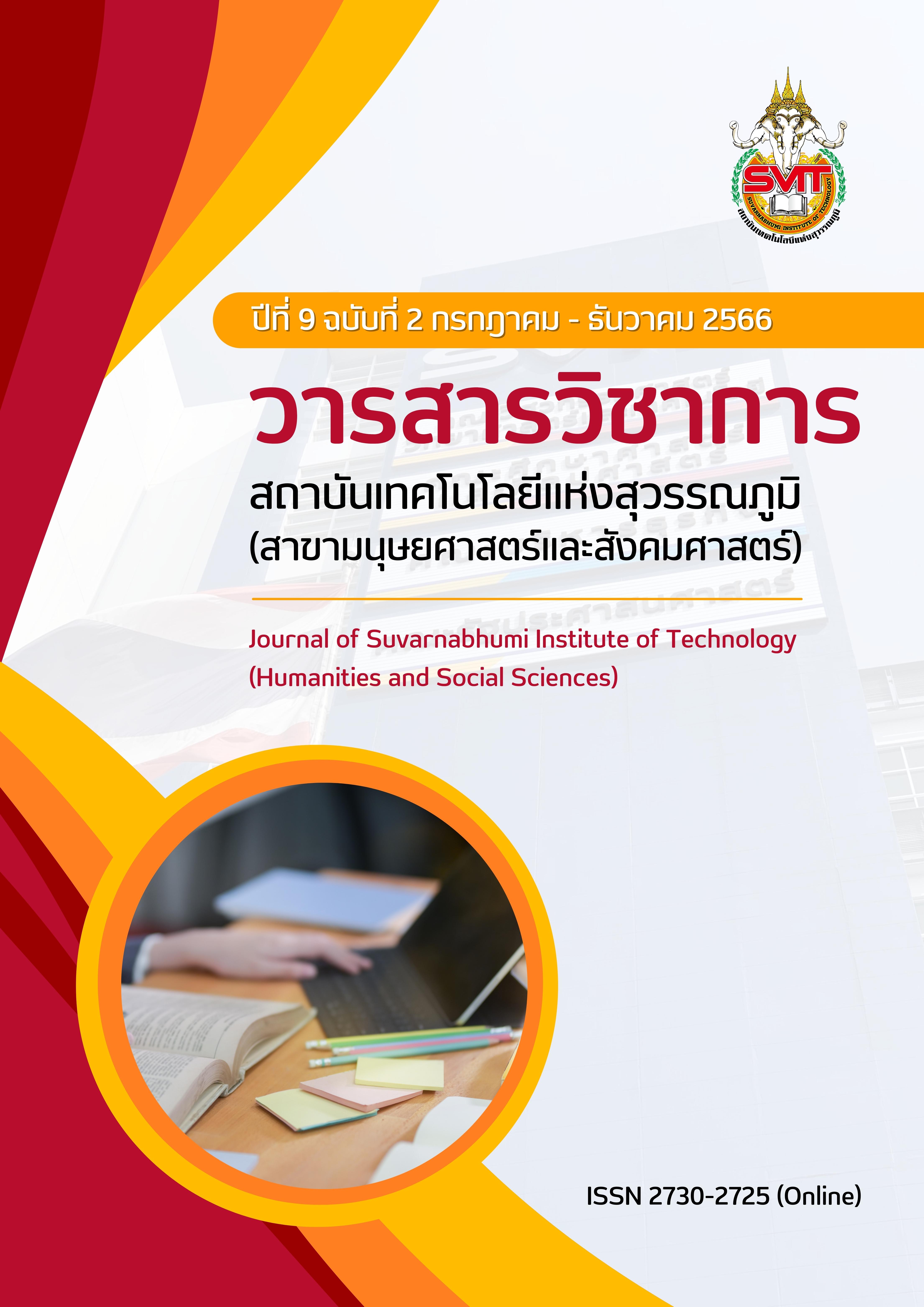BITCOINS: MONEY OF THE FUTURE?
Keywords:
Bitcoin, Cryptocurrency, Money of The FutureAbstract
Cryptocurrencies, one of which is Bitcoin, are becoming widely popular among investors reflecting the new generation and hoping for higher returns than investing in traditional investments. One of the factors attracting people to invest or accumulate Bitcoin is because they believe that Bitcoin is money that could even be the money of the future. This article seeks to investigate whether Bitcoin is money and can act as a substitute for fiat money globally.
This article shows that the volatility of Bitcoin prices calculated as a percentage CV of moving standard deviation is quite high compared to fiat money like the US Dollar and Thai Baht around 8.24 to 11.32 times from 2014 to 2023. This attribute hinders Bitcoin from performing the function of money as a medium of exchange. Such high volatility of Bitcoin also hinders Bitcoin's ability to function as a store of value. As for a unit of account function of money, the small unit of bitcoin that is a million times smaller than its base unit compared to regular fiat money makes it inconvenient to use bitcoin in real-life trading activities and for accounting.
In conclusion, this points out that Bitcoin could not meet the three money functions qualification, Bitcoins, therefore could not perform well as money for now even for the future.
References
Ardia, D., Bluteau,K., & Rüede M (2019) Regime changes in Bitcoin GARCH volatility dynamics. Finance Research Letters, 29, 266–271
Baur, D. G. & Dimpfl, T. (2021). The volatility of Bitcoin and its role as a medium of exchange and a store of value. Empirical Economics, Springer. 61(5), 2663-2683
Bouoiyour, J. & Selmi, R. (2016). Bitcoin: A beginning of a new phase?. Economics Bulletin, 36, 1430-1440.
Bouri E, Azzi G, & Dyhrberg AH (2017). On the return-volatility relationship in the Bitcoin market around the price crash of 2013. Economics: The Open-Access, Open-Assessment E-Journal, 11 (2017-2), 1–16. Retrieved from http://dx.doi.org/10.5018/economics-ejournal.ja.2017-2
Chen, J. (2023). Medium of Exchange: Definition, How It Works, and Example. Investopedia. Retrieved from https://www.investopedia.com/terms/m/mediumofexchange.asp
Chegg. (n.d.). Unit Of Account Definition. Retrieved from https://www.chegg.com/learn/topic/unit-of-account
Dwyer GP (2015) The economics of Bitcoin and similar private digital currencies. Journal of Financial Stability,17, 81–91.
Downey, L. (2022). Store of Value: Definition, How Assets Work, and Examples. Investopedia. Retrieved from https://www.investopedia.com/terms/s/storeofvalue.asp.
Dobija, M. (2014). The Global Currency Area a Way to Constructively End the Era of Reserve Currency. Modern Economy, 5(4), 289-302. Retrieved from http://dx.doi.org/10.4236/me.2014.54029
European Central Bank. (2017). What is Money? Retrieved from https://www.ecb.europa.eu/ecb/educational/explainers/tell-me-more/html/what_is_money.en.html
Graham, F.D. (1940). The Primary Functions of Money and their Consummation in Monetary Policy. The American Economic Review, 30 (1), 1-16.
International Monetary Fund. (2012). What is Money?. Retrieved fromhttps://www.imf.org/external/pubs/ft/fandd/2012/09/basics.htm
Ingram, O. (1960). Contributions to Probability and Statistics: Essays in Honor of Harold Hotelling. USA: Stanford University.
Klemens, S. (2020). How long Does a Bitcoin Transaction Take? Bitcoin Unconfirmed Transactions. Retrieved from https://www.exodus.com/news/how-long-does-a-bitcoin-transaction-take/
Katsiampa, P. (2017) Volatility estimation for bitcoin: a comparison of GARCH models. Economics Letters, 158, 3–6
Krishnan, A. (2020). Blockchain Empowers Social Resistance and Terrorism Through Decentralized Autonomous Organizations. Journal of Strategic Security, 13 (1), 41-58.
Levene, H. (1960). Robust tests for equality of variances. In Ingram Olkin: Harold.
Luther, W. (2016). Bitcoin and the Future of Digital Payments. The Independent Review, 20 (3), 397-404.
Max, K. (2015). Virtual currency bitcoin in the scope of money definition and store of Value. Procedia Economics and Finance, 30(2015), 409 – 416.
Moshirian, F. (2007). Global financial services and a global single currency. Journal of Banking & Finance, 31(1), 3-9.
Mishkin, F. S., Gamber, E., & Hakes, D. (2006). The Economics of Money, Banking and Financial Markets. USA: Addison-Wesley Longman.
Nakamoto S (2008) Bitcoin: a peer-to-peer electronic cash system. Retrieved from https://bitcoin.org/bitcoin.pdf
Pierce, D. G., & Tysome, P. J. (2014). Monetary Economics, Theories, Evidence and Policy (2nd ed.). Cambridge, UK: University Press
Trend Spider Learning Center. (n.d.) What is the Moving Standard Deviation (MSD). Retrieved from https://trendspider.com/learning-center/what-is-the-moving-standard-deviation-msd/
Yang, B. Z. (2007). WHAT IS (NOT) MONEY? MEDIUM OF EXCHANGE ≠ MEANS OF PAYMENT. The American Economist., 51 (2), 101-104.
Spruzen, B. (2001). The Social Constructions of Money. Australian Journal of Environmental Education, 17 (2001), 127-129.
Downloads
Published
Issue
Section
License
Copyright (c) 2023 Suvarnabhumi Institute of Technology

This work is licensed under a Creative Commons Attribution-NonCommercial-NoDerivatives 4.0 International License.
บทความที่ได้รับการตีพิมพ์เป็นลิขสิทธิ์ของวารสารวิชาการ สถาบันเทคโนโลยีแห่งสุวรรณภูมิ
ข้อความที่ปรากฏในบทความแต่ละเรื่องในวารสารวิชาการเล่มนี้เป็นความคิดเห็นส่วนตัวของผู้เขียนแต่ละท่านไม่เกี่ยวข้องกับสถาบันเทคโนโลยีแห่งสุวรรณภูมิ และคณาจารย์ท่านอื่นๆในสถาบันฯ แต่อย่างใด ความรับผิดชอบองค์ประกอบทั้งหมดของบทความแต่ละเรื่องเป็นของผู้เขียนแต่ละท่าน หากมีความผิดพลาดใดๆ ผู้เขียนแต่ละท่านจะรับผิดชอบบทความของตนเองแต่ผู้เดียว





